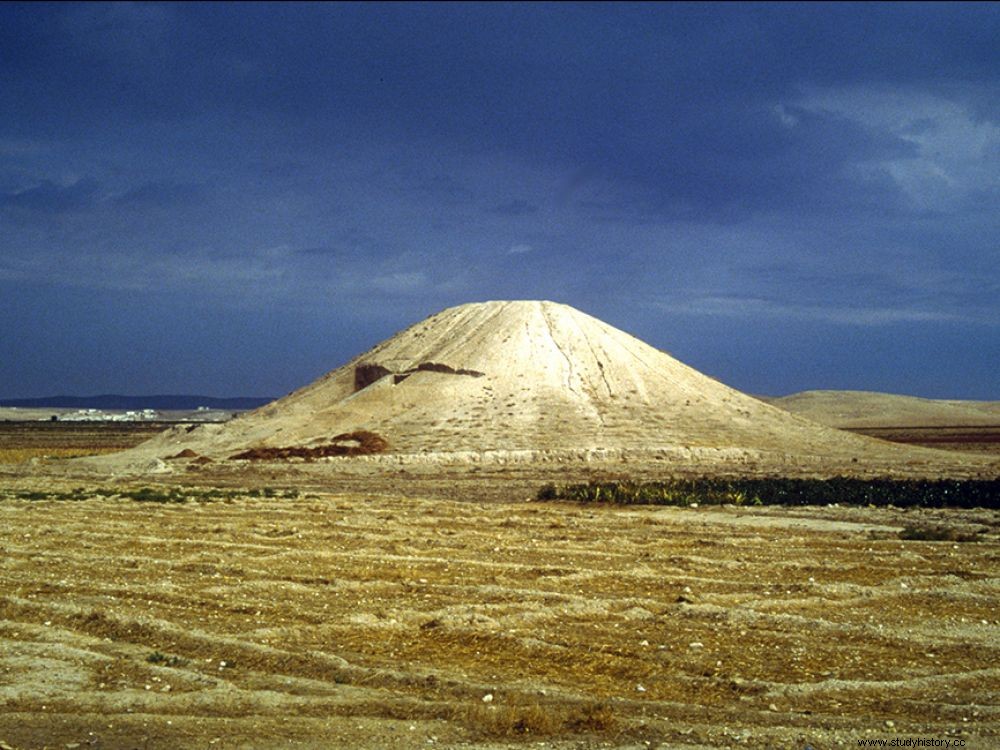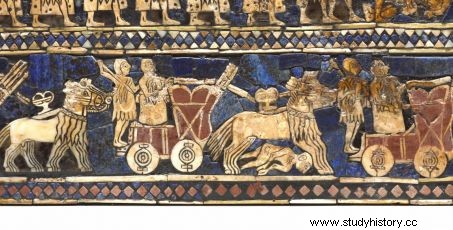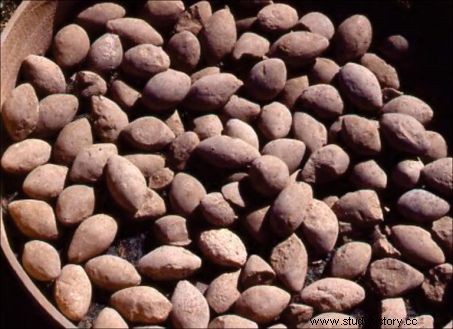On the site of Tell Banat, in northern Syria, the mound called the "White Monument" housed a vertical cemetery dating from the third millennium BC. Bringing together fallen soldiers, it could have played a highly symbolic role:asserting the dominance of a powerful state.

The White Monument, on the site of Tell Banat in Syria, is now under the waters of the Tishrine Dam.
In the north of present-day Syria and ancient Mesopotamia, in the Euphrates valley, near the site of Tell Banat, rose a conical mound, covered with white gypsum, which shimmered as far as the eye could see. Salvage archaeological excavations, carried out during the decade preceding the immersion of the valley by a dam, suggest that this mound, which housed several burial mounds and contained numerous bones dating from the end of the third millennium BC, would be a one-of-a-kind funerary monument:it would indeed be the oldest known war memorial.
The mound of Tell Banat North houses a unique vertical cemetery
On the left bank of the middle Euphrates, 200 meters north of the Banat/Bazi complex, was a small conical mound 22 meters high and 100 meters in diameter, which archaeologists have named Tell Banat North. Salvage excavations were carried out there between 1988 and 1999 by Thomas McClellan of the Euphrates Salvage Project and Anne Porter of the University of Toronto, before the river valley was flooded by the Tichrin Dam. The first results, which have just been published in the journal Antiquity , indicate that this mound nicknamed "the White Monument", because it shone in the sun because of the layers of gypsum and marl with which it was covered, was built in at least three phases and that it was a cemetery. one-of-a-kind vertical.
According to geophysical surveys, the first phase of the site probably corresponded to a mound of earth erected on graves, the whole forming a first mound with a smooth surface, which it was however not possible to excavate or date before the construction of the dam.
During the second phase of construction, dating from 2700/2600-2450 BC, the mound was covered with an initial coating of gypsum, then a series of stone and earth mounds were superimposed on the previous phase. In the four burial mounds they were able to excavate, the archaeologists found fragmentary and disarticulated remains of several people (between 2 and 5 per burial), as well as animal bones, ceramics and biconical earth balls. These burial mounds were also unified by a new layer of white gypsum, the surface of which was then pounded in strips to achieve a wavy effect.
A step pyramid encrusted with bones
In the north of present-day Syria and ancient Mesopotamia, in the Euphrates valley, near the site of Tell Banat, rose a conical mound, covered with white gypsum, which shimmered as far as the eye could see. Salvage archaeological excavations, carried out during the decade preceding the immersion of the valley by a dam, suggest that this mound, which housed several burial mounds and contained numerous bones dating from the end of the third millennium BC, would be a one-of-a-kind funerary monument:it would indeed be the oldest known war memorial.
The mound of Tell Banat North houses a unique vertical cemetery
On the left bank of the middle Euphrates, 200 meters north of the Banat/Bazi complex, was a small conical mound 22 meters high and 100 meters in diameter, which archaeologists have named Tell Banat North. Salvage excavations were carried out there between 1988 and 1999 by Thomas McClellan of the Euphrates Salvage Project and Anne Porter of the University of Toronto, before the river valley was flooded by the Tichrin Dam. The first results, which have just been published in the journal Antiquity , indicate that this mound nicknamed "the White Monument", because it shone in the sun because of the layers of gypsum and marl with which it was covered, was built in at least three phases and that it was a cemetery one-of-a-kind vertical.
According to geophysical surveys, the first phase of the site probably corresponded to a mound of earth erected on graves, the whole forming a first mound with a smooth surface, which it was however not possible to excavate or date before the construction of the dam.
During the second phase of construction, dating from 2700/2600-2450 BC, the mound was covered with an initial coating of gypsum, then a series of stone and earth mounds were superimposed on the previous phase. In the four burial mounds they were able to excavate, the archaeologists found fragmentary and disarticulated remains of several people (between 2 and 5 per burial), as well as animal bones, ceramics and biconical earth balls. These burial mounds were also unified by a new layer of white gypsum, the surface of which was then pounded in strips to achieve a wavy effect.
A step pyramid encrusted with bones
It is the last phase of the "White Monument", carried out between 2450 and 2300 BC, which has most interested archaeologists, because it does not reproduce the same construction scheme - an elevation of the previous mound -, but differs from earlier phases as much in its appearance as in the mode of burial.
This time, in fact, the mound has been extended horizontally, in stages of about 50 centimeters in height by 1 meter in width. The "White Monument" must have looked like a step pyramid, perhaps also covered with gypsum, the researchers assume, before erosion came to blur the edges to give it the shape of a ridged dome that we stands out in the photographs. A somewhat special step pyramid, however, since the embankments of each floor incorporated bones, most often human, directly placed on the ground, according to an order and spatial patterns that archaeologists have reconstructed and for which they offer an interpretation.
An army of fighters
The analyzes of 18 bone deposits revealed a recurrent structure, with a distinction between strictly human deposits and deposits integrating animal bones. Thus, to the northwest of the mound, the bone deposits almost systematically correspond to a male couple comprising a young adult and an adolescent, associated with the remains of equines. In the southwest, the deposits more often contain the bones of a single person, surrounded by various objects, including rings, a model of a covered wagon and especially biconical balls. Archaeologists deduce that the bones embedded in the monument belonged to soldiers of an army. Tank crews on one side, infantry on the other.
The tank crews
As seen on the "Face of War" of the famous Standard of Ur on display at the British Museum in London, the four-wheeled war chariots of the Sumerian army were drawn by equines and driven by a crew of two. soldiers. One, positioned above the rear axle, held the reins, while the other sat on a step at the rear of the vehicle, to serve as a counterweight and allow the tank to maneuver. The teenagers found at Tell Banat could therefore have been acrobatic riders, who served as "jumpers" for the combat cars, and which were bought at the same time as the kunga , prestigious equines. These highly prized animals, presumably derived from a cross between the donkey and the evening primrose, were primarily used to pull carts. In the Tell Banat deposits, the equine remains were too fragmented to allow conclusive identification, but a complete pastern matched kunga bones identified at the nearby site of Umm el Marra.

Detail of the "war side" of the Standard of Ur (2700/2600 BC). © The Trustees of the British Museum / CC BY-NC-SA 4.0
Infantry armed with dirt pebbles
Biconical earthen balls represent another distinctive feature that archaeologists have attempted to interpret. Their presence is not attested in any burial in the region dating from the third millennium BC, but they have been found on other sites in northern Syria:behind the courtyard of the palace of Nagar, on the site of Tell Brak, where the kunga were raised , as on the site of Hamoukar, where they were used at the same time to attack the fortified city. It could therefore be projectiles that one could have launched with slingshots, and the people buried in the south-western quadrant of the "White Monument" of Tell Banat would therefore have been infantrymen, equipped with slingshots to rain down a hail of potentially lethal blows on the enemy.

Biconical earth balls found on the site of Tell Banat North. © Euphrates Salvage Project / Antiquity Publications
A symbol of ostensible power
The mound of Tell Banat Nord "is unlike any other mortuary context in the Near East ", say the researchers. So how to understand the meaning and function of this monument with strong symbolic value?
Are the fighters whose remains are buried on the site defeated enemies or glorified soldiers? To decide this, the researchers rely on the representations of funerary mounds identified in Mesopotamian inscriptions, depicting piles of enemy corpses. But their essential function is to symbolize punishment and victory, and no archaeological example has so far been found. Be that as it may, the disposition of the bones of Tell Banat does not reproduce these disorderly piles.
For archaeologists, it is clear that the bones of Tell Banat North, which correspond to a secondary burial and come from another original site, a battlefield or a cemetery, "were selected, arranged and finally monumentalized with care, long after death ". It is therefore a staging, which had not only a symbolic value, but also a warning function. The height of the construction, its visibility also due to its flickering, indicate that the "White Monument " was addressed not only to the local population, but to all the inhabitants of the river valley, the steppe and beyond, to signify the presence in this location of a powerful state, capable of mustering an army of soldiers and to honor them beyond time for the victories won.
